Nature in Ryde Cemetery – April 2008
On Saturday 5 April, Carol and I had our monthly walk around the Cemetery to record and photograph the natural life there. It was a very nice day with warm sunshine and just a gentle breeze. At first we did not see anything new to report but as we walked around it became apparent that Spring is really in the air.
The Primroses that have been in flower since early January are blooming and growing in profusion in all parts of the cemetery. It is well worth a stroll through the cemetery just to see them.
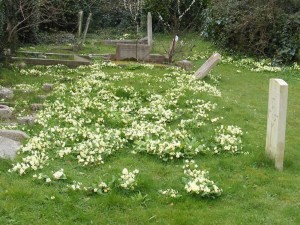
Primroses
The Pussy Willow that I mentioned last month is now full of yellow catkins, and the bees and insects are very busy all over this tree which is at the Pellhurst Road end of the Cemetery. We think it is either a Goat Willow or a Grey Willow.
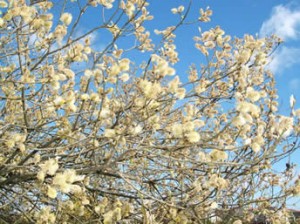
Willow
As we walked around the birds were singing, we heard a Dunnock and we also saw a Blackbird, a Robin, many Wood pigeons and a very large Rook.
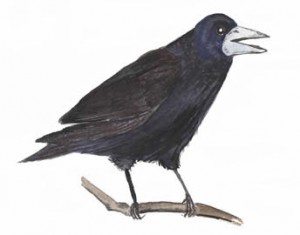
Rook
We also noticed many of the plants are in bud and by next month when we do our Nature Walk they should be in full bloom.
We did find Germander Speedwell, Wood Anemone, Oxlips, Dandelions, Chickweed, Celandines, Daisies, Wild Strawberry, Field Pennycress, Bluebells (as well as the normal blue some of were pink and some white), Herb Robert, Green Alkanet and Cow Parsley.
Anemone nemorosa (Ranunculaceae)

An early spring flower, normally found in copses, woodland and in upland meadows.
It is perennial with creeping rootstock which sends up stems with folded leaves and drooping buds. The flowers have white petals, often flushed with pink underneath, they open fully only in good light and follow the direction of the sun.
Flowers from March to June.
Herb Robert
Geranium robertianum (Geraniaceae)
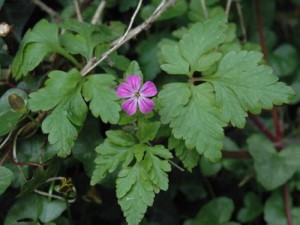
The leaves are deeply lobed and toothed, often scented and red tinged. The small flowers are bright pink, with white centres, two red stripes along their length and orange anthers. It is an Annual/Biennial and grows in semi-shaded placed, in old walls, woodland glades and well drained sites.
Normally flowers from May to September.
Bluebell
Scilla non-scripta (Liliaceae)

The bluebell can form dense carpets of blue in woodland where it blooms just as the trees are coming into leaf. The nodding, bell-shaped, violet blue (occasionally white or pink) flowers have creamy white anthers. The leaves are narrow and dark green.
Flowers April to May.
Green Alkanet
Pentaglottis sempervirens (Boraginaceae)
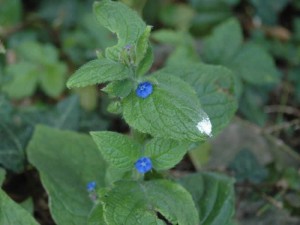
The large, slightly bristly, basal leaves of Green Alkanet are formed early in the year and are somewhat wrinkled, and paler beneath. The flowering shoots bear coiled clusters of blue flowers, each with a pure white throat and spreading, rounded petals.
Likes damp, semi shaded sites, woodland margins, hedgebanks and roadsides.
Flowers April to July
The Friends of Ryde Cemetery were having an Activity Day in the Cemetery on 5th April and while some of the group were cutting back ivy from one Grave they found a Slow-worm, which they carefully placed in the undergrowth covering a nearby grave. We have previously noted the presence of slow worms in the cemetery as shown in this photograph.
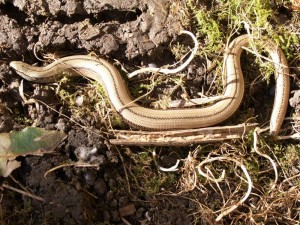
Slow Worm
FORC also found this rather ferocious looking spider, we have been unable to give it a positive identification, but after taking its photograph it was returned to the safety of the undergrowth in the cemetery.

Spider
The Bay is in flower, the Ivy is in bud and already the insects are buzzing around. Near the old Chapel of St Paul in the Old Parish Cemetery there are a couple of small trees in blossom, I think they could be Damson or Sloes.
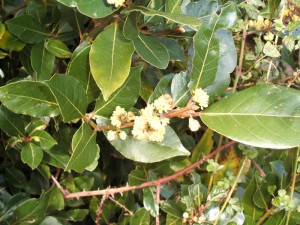
Bay
Yet again we found the some unpleasant things on our walk around the cemetery – dogs’ mess (some of which was right beside the main paths and on grave tops) and we also found many discarded empty beer bottles and cans – a sad reflection on our society and the ‘couldn’t care less’ attitude of some people.
If you would like to help with our Nature Studies, and particularly if you have any expertise in this area, please get in touch, we would welcome you to our team, and please get in touch if you believe I have named any of the plants incorrectly.
Maisie Kitching
7 April 2008
UPDATE 30.4.2008
St Mark’s flies
Bibio marci
While the Transcribing Group were in the Cemetery on the morning of Saturday 25 April 2008 we were surrounded by a swarm of black flies slowly flying through the air with their long back legs dangling. Although there were masses of these flies they didn’t bite or disturb us too much. The flies are called St Mark’s flies as they usually appear on or around 25th April which is St Marks day. They normally all disappear after just a fortnight. They inhabit hedgerows and woodland edges. They fly in a sluggish manner above hedgerows and grass, with their long legs dangling down. They help with the pollination of fruit trees, while their larvae feed on leaf mould.
Green Winged Orchid
Also on 25 April we spotted an orchid which we believe to be a Green Winged Orchid.
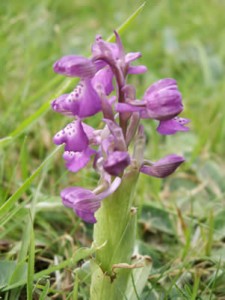
Green Winged Orchid
Janette Gregson
30 April 2008
